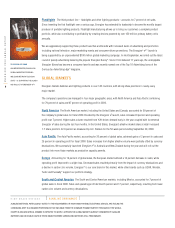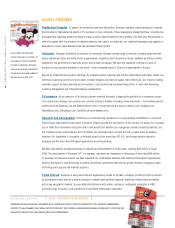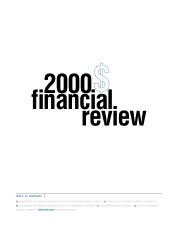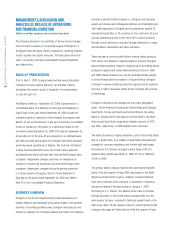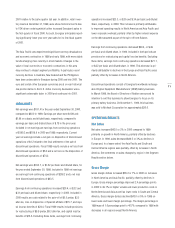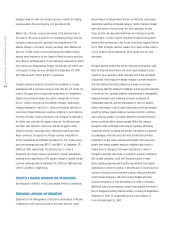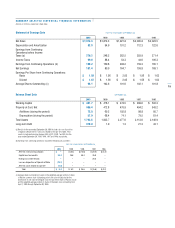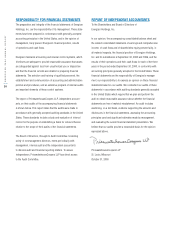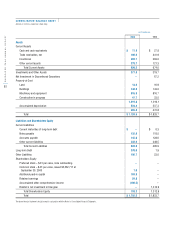Energizer 2000 Annual Report Download - page 18
Download and view the complete annual report
Please find page 18 of the 2000 Energizer annual report below. You can navigate through the pages in the report by either clicking on the pages listed below, or by using the keyword search tool below to find specific information within the annual report.
ENERGIZER 2000 ANNUAL REPORT
16
Immediately prior to the spin-off, Ralston borrowed $478.0 through
several interim funding facilities and assigned all repayment obliga-
tions of those facilities to Energizer. In April and May, 2000,
Energizer entered into separate financing agreements and repaid
the interim funding facilities. As of September 30, 2000, Energizer’s
financing agreements include the following: private placement notes
of $175.0 with maturities of 3 to 10 years; borrowings of $195.0
under revolving credit facilities, generally with 5 year maturities;
an agreement to sell domestic trade receivables as discussed
below; and other short-term borrowings. The average interest
rate on the domestic short-term and long-term debt is approximately
7.1% and 7.8%, respectively. Approximately $195.0 of the long-
term debt has a variable interest rate. The interest rates on the
long-term debt range from 7.3% to 8.0%. Energizer maintains
total committed debt facilities of $625.0, of which $255.0 remained
available as of September 30, 2000. Under the terms of the facilities,
the ratio of Energizer’s total indebtedness to its EBITDA cannot be
greater than 3 to 1 and the ratio of its EBIT to total interest expense
must exceed 3 to 1.
On a historical basis, Energizer’s ratio of total indebtedness to
EBITDA was 1.5 to 1 and the ratio of EBIT to total interest expense
was 11.2 to 1 as of September 30, 2000. On a pro forma basis,
which assumes the post-spin debt was outstanding for the full year,
these ratios would have been 1.5 to 1 and 6.8 to 1, respectively, at
September 30, 2000.
Energizer entered into an agreement to sell, on an ongoing basis,
a pool of domestic trade accounts receivable to a wholly owned
bankruptcy-remote subsidiary of Energizer. Energizer received
$100.0 of proceeds from this arrangement, which was used to repay
interim funding facilities as discussed above. See Note 12 to the
Consolidated Financial Statements for further discussion regarding
the sale of accounts receivable.
In September 2000, Energizer’s Board of Directors approved a share
repurchase plan authorizing the repurchase of up to 5 million shares
of Energizer’s common stock. Subsequent to year-end through
November 10, 2000, approximately 1,150,000 shares of Energizer
common stock had been purchased under the authorization.
Energizer believes that cash flows from operating activities and
periodic borrowings under existing credit facilities will be adequate
to meet short-term and long-term liquidity requirements prior to
the maturity of Energizer’s credit facilities, although no guarantee
can be given in this regard.
INFLATION
Management recognizes that inflationary pressures may have an
adverse effect on Energizer through higher asset replacement costs
and related depreciation and higher material, labor and other costs.
Energizer tries to minimize these effects through cost reductions
and productivity improvements as well as price increases to main-
tain reasonable profit margins. It is management’s view, however,
that inflation has not had a significant impact on operations in the
three years ended September 30, 2000.
SEASONAL FACTORS
Energizer’s results are significantly impacted in the first quarter
of the fiscal year by the additional sales volume associated with
the Christmas holiday season, particularly in North America. First
quarter sales accounted for 35%, 31% and 33% of total net sales
in 2000, 1999 and 1998, respectively. The first quarter percentage
in 2000 was also higher due to Y2K-driven demand.
ENVIRONMENTAL MATTERS
The operations of Energizer, like those of other companies engaged
in the battery business, are subject to various federal, state, foreign
and local laws and regulations intended to protect the public health
and the environment. These regulations primarily relate to worker
safety, air and water quality, underground fuel storage tanks and
waste handling and disposal.
Energizer has received notices from the U.S. Environmental
Protection Agency, state agencies, and/or private parties seeking
contribution, that it has been identified as a “potentially responsible
party” (PRP) under the Comprehensive Environmental Response,
Compensation and Liability Act, and may be required to share in the
cost of cleanup with respect to nine federal “Superfund” sites. It may
also be required to share in the cost of cleanup with respect to a


